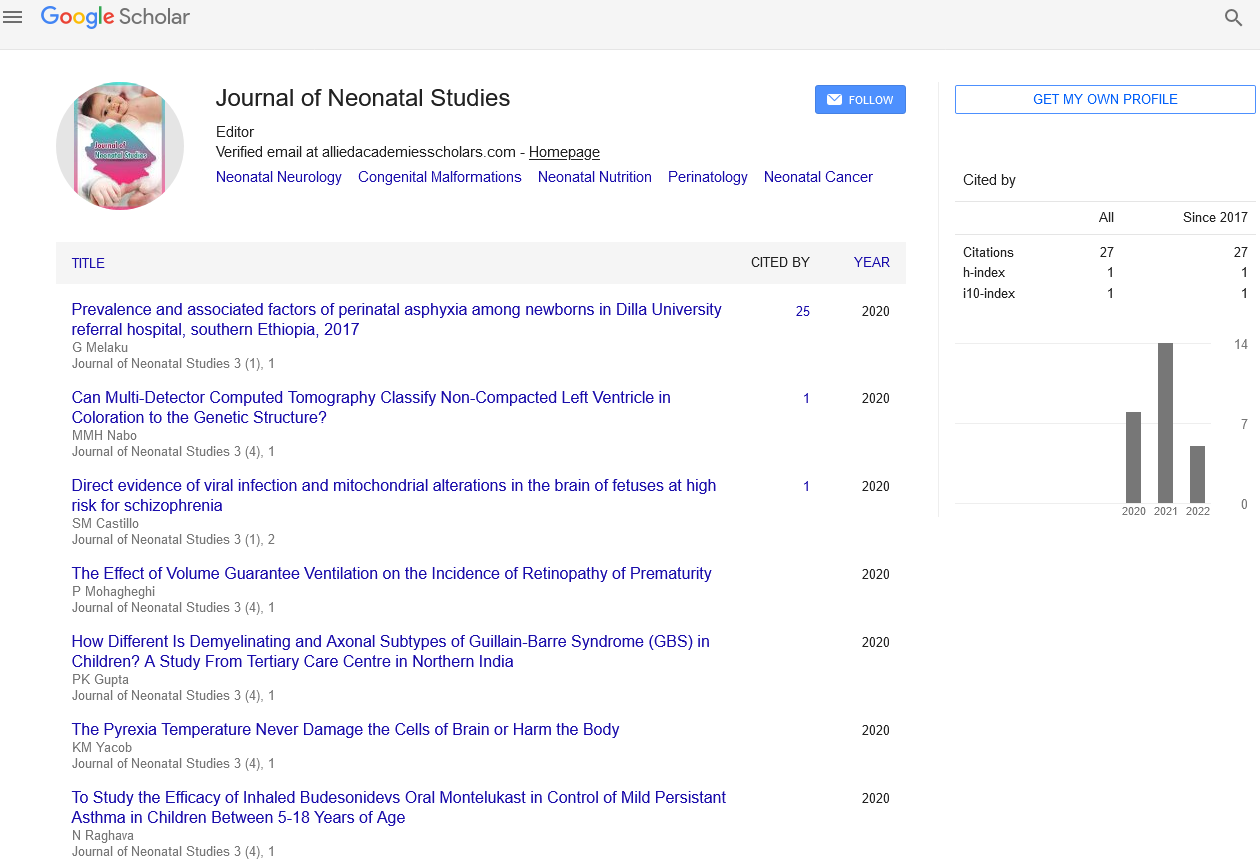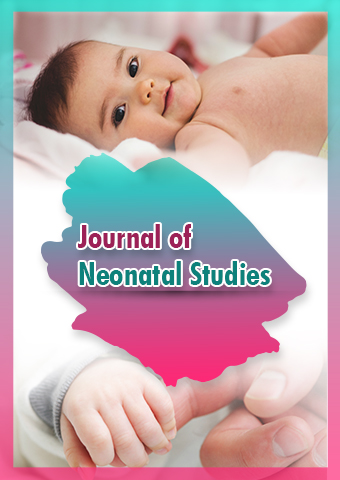Mini Review - Journal of Neonatal Studies (2023) Volume 6, Issue 3
Neonatal Ventilation: Ensuring Healthy Respiratory Support for Newborns
Roehm Pamela*
Department of Otolaryngology, New York University School of Medicine, New York, USA
Department of Otolaryngology, New York University School of Medicine, New York, USA
E-mail: roehm.pamela@nyumc.edu.org
Received: 01-June-2023, Manuscript No. jns-23-104282; Editor assigned: 2-June-2023, PreQC No. jns-23- 104282(PQ); Reviewed: 15-June- 2023, QC No. jns-23-104282; Revised: 23-June-2023, Manuscript No. jns-23- 104282(R); Published: 30-June-2023; DOI: 10.37532/jns.2023.6(3).61-63
Abstract
Neonatal ventilation, also known as newborn respiratory support, plays a crucial role in providing assistance to infants with respiratory distress and ensuring their optimal oxygenation and ventilation. It is a specialized area of neonatal care that requires careful consideration of various factors, including gestational age, underlying respiratory conditions, and the specific needs of each newborn. This article aims to explore the importance of neonatal ventilation, discuss different ventilation strategies and techniques, highlight challenges and considerations, and emphasize the goal of promoting healthy respiratory outcomes for newborns.
Keywords
Neonatal ventilation • Newborn • Infants • Birth • Oxygenation
Introduction
Need for neonatal ventilation
Newborn infants, especially those born prematurely or with respiratory conditions, may experience respiratory distress, resulting in inadequate gas exchange. Neonatal ventilation is employed to support their respiratory function, maintain adequate oxygenation and ventilation, and prevent complications associated with respiratory failure. It plays a critical role in stabilizing infants’ respiratory status, allowing them to grow and develop while their lungs mature.
Ventilation strategies and techniques
Non-invasive ventilation
Non-invasive ventilation techniques are often the first line of respiratory support in neonates. This includes methods such as nasal Continuous Positive Airway Pressure (CPAP) and Nasal Intermittent Positive Pressure Ventilation (NIPPV). These strategies provide respiratory assistance without the need for intubation and mechanical ventilation, reducing the risk of complications associated with invasive procedures [1].
Conventional mechanical ventilation
Conventional mechanical ventilation involves the use of endotracheal intubation and positive pressure ventilation. It is employed in more severe cases of respiratory distress or when noninvasive methods are insufficient. Ventilators deliver a controlled mixture of oxygen and air into the infant’s lungs, ensuring adequate ventilation. Ventilatory parameters such as tidal volume, respiratory rate, and Positive End-Expiratory Pressure (PEEP) are carefully adjusted based on the infant’s condition and response.
High-frequency oscillatory ventilation (HFOV)
HFOV is a specialized ventilation technique that utilizes very high-frequency oscillations to deliver small tidal volumes rapidly. This approach helps maintain lung recruitment and oxygenation while reducing the risk of lung injury. HFOV is commonly employed in infants with severe respiratory failure or those with conditions such as meconium aspiration syndrome or persistent pulmonary hypertension of the newborn [2, 3].
Challenges and considerations
Neonatal ventilation poses several challenges and requires careful monitoring and management. Some considerations include:
Lung protection
The delicate lung tissue of newborns requires careful protection during ventilation to avoid lung injury. Strategies such as limiting tidal volumes, optimizing ventilatory settings, and utilizing lung-protective ventilation approaches, such as Synchronized Intermittent Mandatory Ventilation (SIMV) or volume-targeted ventilation, aim to minimize lung damage.
Avoiding ventilator-induced lung injury (VILI)
Excessive pressure or volume during mechanical ventilation can lead to VILI. Measures to mitigate this risk include optimizing ventilator settings, monitoring airway pressures, utilizing lungprotective strategies, and avoiding prolonged ventilation when possible.
Infection control
Neonatal ventilation requires strict adherence to infection control protocols, including hand hygiene, aseptic techniques during intubation, and proper maintenance and cleaning of ventilator equipment. Infections, such as ventilator-associated pneumonia, can further complicate respiratory conditions in newborns [4].
Individualized care
Each newborn requires an individualized approach to ventilation based on their specific respiratory needs. Factors such as gestational age, underlying lung pathology, blood gas measurements, and continuous monitoring guide ventilation strategies and adjustments.
Promoting healthy respiratory outcomes
The ultimate goal of neonatal ventilation is to promote healthy respiratory outcomes for newborns. This includes:
Neonatal ventilation: enhancing respiratory support for newborns
Neonatal ventilation, also referred to as newborn respiratory support, is a critical aspect of neonatal care that focuses on providing assistance to infants with respiratory distress. It involves various techniques and strategies aimed at optimizing oxygenation and ventilation, ensuring adequate gas exchange, and supporting the infant’s respiratory system during a crucial developmental period. This discussion aims to delve into the complexities of neonatal ventilation, exploring its significance, different ventilation modalities, challenges, and advancements in the field [5, 6].
Discussion
The importance of neonatal ventilation
Newborn infants, especially those born prematurely or with respiratory complications, often face challenges in maintaining proper respiratory function. Neonatal ventilation plays a pivotal role in supporting their fragile respiratory system and ensuring optimal oxygenation and ventilation. By providing respiratory support, neonatal ventilation helps prevent complications related to respiratory distress, promotes lung development, and improves overall outcomes for these vulnerable infants [7].
Ventilation modalities in neonates
Non-invasive ventilation (NIV)
Non-invasive ventilation techniques, such as nasal Continuous Positive Airway Pressure (CPAP) and Nasal Intermittent Positive Pressure Ventilation (NIPPV), are commonly used as initial respiratory support strategies. NIV delivers a flow of air or a mixture of air and oxygen through nasal prongs or masks, promoting lung expansion and enhancing gas exchange. NIV is effective in preventing or reducing the need for invasive mechanical ventilation, reducing complications associated with intubation [7].
Conventional mechanical ventilation
Conventional mechanical ventilation involves the use of an endotracheal tube and a mechanical ventilator to deliver controlled breaths to the infant’s lungs. It is employed when non-invasive methods are insufficient or in cases of severe respiratory distress. Ventilatory parameters, such as tidal volume, respiratory rate, inspiratory time, and Positive End-Expiratory Pressure (PEEP), are adjusted based on the infant’s condition. Conventional mechanical ventilation provides precise control over ventilation parameters but carries the risk of lung injury if not carefully managed [8].
High-frequency ventilation (HFV)
High-frequency ventilation techniques, such as High-Frequency Oscillatory Ventilation (HFOV) and High-Frequency Jet Ventilation (HFJV), utilize rapid rates of small-volume breaths to deliver oxygen and support ventilation. HFV is particularly useful in infants with severe lung pathology or those with fragile lungs, as it helps maintain lung recruitment and oxygenation while reducing the risk of barotrauma or volutrauma associated with conventional ventilation. These techniques require specialized equipment and expertise [9, 10].
Conclusion
Challenges and considerations
Neonatal ventilation presents several challenges and considerations that need to be addressed for optimal outcomes:
Lung protection
The fragile lungs of newborns are susceptible to injury. Lung-protective strategies, such as using low tidal volumes, maintaining appropriate PEEP, and minimizing exposure to high oxygen concentrations, are crucial to mitigate the risk of lung injury, including bronchopulmonary dysplasia (BPD).
Management of respiratory distress syndrome (RDS)
Premature infants often develop respiratory distress syndrome due to surfactant deficiency. Ventilatory strategies that incorporate early surfactant administration, along with lungprotective ventilation, have shown improved outcomes in managing RDS and reducing the need for prolonged ventilation.
Optimal oxygenation
Achieving and maintaining appropriate oxygenation is vital in neonatal ventilation. Continuous monitoring of oxygen saturation levels, arterial blood gas analysis, and the use of pulse oximetry guides the adjustment of oxygen concentrations to avoid both hypoxemia and hypoxemia.
Infection prevention
Ventilator-associated infections, such as ventilator-associated pneumonia, pose a significant risk in neonatal ventilation.
Acknowledgement
None
Conflict of Interest
None
References
- Nimmerjahn F, Ravetch JV. Fc-receptors as regulators of immunity. Adv Immunol. 96, 179-204 (2007).
- Nimmerjahn F, Ravetch JV. Fcgamma receptors: Old friends and new family members. Immunity. 24, 19-28 (2006).
- Brambell FW. The transmission of immunity from mother to young and the catabolism of immunoglobulins. Lancet. 2, 1087-1093 (1966).
- Pyzik M, Sand KMK, Hubbard JJ et al. The Neonatal Fc Receptor (FcRn): A Misnomer Front. Immunol. 10, 1540 (2019).
- Andersen JT, Daba MB, Berntzen G et al. Cross-species binding analyses of mouse and human neonatal Fc receptor show dramatic differences in immunoglobulin G and albumin binding. J Biol Chem. 285, 4826-4836 (2010).
- Bonati M. Early neonatal drug utilisation in preterm newborns in neonatal intensive care units: Italian collaborative group on preterm delivery. Dev Pharmacol Ther. 11, 1-7 (1988).
- Eriksson M. Neonatal septicemia. Acta Paediatr. Scand. 72, 1-8 (1983).
- Schelonka RL, Infante AJ. Neonatal immunology. Semin Perinatol. 22, 2-14 (1998).
- Friis-Hansen B. Body water compartments in children: changes during growth and related changes in body composition. Pediatrics. 28, 169-181 (1961).
- Morselli PL, Franco Morselli R. Clinical pharmacokinetics in newborns and infants. Age-related differences and therapeutic implications. Clin Pharmacokinet. 5, 485-527 (1980).
Indexed at, Google Scholar Crossref
Indexed at Google Scholar Crossref
Indexed at Google Scholar Crossref
Indexed at Google Scholar Crossref
Indexed at, Google Scholar Crossref
Indexed at, Google Scholar, Crossref
Indexed at, Google Scholar, Crossref
Indexed at, Google Scholar, Crossref

